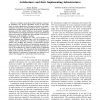Free Online Productivity Tools
i2Speak
i2Symbol
i2OCR
iTex2Img
iWeb2Print
iWeb2Shot
i2Type
iPdf2Split
iPdf2Merge
i2Bopomofo
i2Arabic
i2Style
i2Image
i2PDF
iLatex2Rtf
Sci2ools
103
Voted
IROS
2007
IEEE
2007
IEEE
"Talk to me!": enabling communication between robotic architectures and their implementing infrastructures
— Complex, autonomous robots integrate a large set of sometimes very diverse algorithms across at least three levels of system organization: the agent architecture, the implementation environment, and the hardware devices. Insofar as a distinction is maintained between them, the levels serve different purposes and thus exhibit different characteristic strengths and weaknesses. Exchanging information among organizational levels can be used to mitigate the shortcomings of one level by making use of the strengths of another. In this paper, we highlight the roles, characteristics, and relations between the infrastructure and the architecture of complex robots, describing a novel form of integration that results from enabling the exchange of information between these two levels, which otherwise is maintained internally. The information from the infrastructure is especially amenable for use by the architecture to achieve a higher level of robustness and system awareness. We demonstrate the...
Related Content
| Added | 03 Jun 2010 |
| Updated | 03 Jun 2010 |
| Type | Conference |
| Year | 2007 |
| Where | IROS |
| Authors | James F. Kramer, Matthias Scheutz, Paul W. Schermerhorn |
Comments (0)

